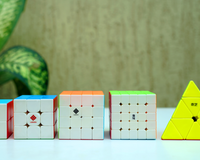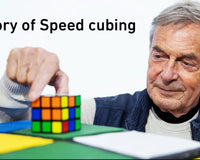In the world of twisty puzzles, The Rubik's Cube has reigned supreme for decades, captivating people with its complexity. However, solving a Rubik’s Cube is really easy once you’ve learned how to do so, and even though you can always take up the challenge of getting faster at the Rubik’s Cube, there’s always a hunger for a new challenge. So, for those seeking an extra challenge and a twist on the iconic puzzle, the Axis Cube emerges as a fantastic alternative! An Axis cube is a 3x3 shape mod that is one of the most challenging puzzles to solve. But if you know how to solve a 3x3, you probably won’t struggle! Due to the bizarre structure of the Axis cube, it turns into a weird shape upon scrambling. Crazy, right? In this blog, we'll delve deeper into the fascinating Axis Cube, exploring its origins, its unique design, and providing a step-by-step guide on how to solve it.
What is the Axis Cube?

The Axis Cube is a shape modification of the classic 3x3 Rubik's Cube. While the Rubik's Cube features an arrangement of small cubes, each with a single square face, the Axis Cube introduces an additional layer of complexity. In this puzzle, the centerpiece has 2 colors. Both the corners and edges are of two types each, adding a fresh twist to the solving experience.
Invention and Evolution

The Axis Cube was invented by Tony Fisher, a puzzle enthusiast and designer, known for his innovative twisty puzzles. Fisher created the Axis Cube in 2010. His aim was to introduce a unique variation to the Rubik's Cube that would challenge even the most seasoned cubers.
Since its inception, the Axis Cube has gained popularity among puzzle enthusiasts worldwide. Its innovative design and its intriguing challenge have made it a sought-after addition to many puzzle collections.
How to Solve the Axis Cube
Solving the Axis Cube requires a solid understanding of the puzzle's mechanics. Here, we will outline a step-by-step guide to help you navigate the solving process:
Step 1: Solving the Cross

Begin by picking a center of the Axis Cube and start solving your cross. While solving the cross make sure the 4 center pieces of the middle layer are aligned correctly.
Step 2: Solving the First Layer
After you’re done with the cross, put the corners in place just like you would in a regular 3x3. It takes some time to recognize the corner pieces but it’s pretty easy.
Step 3: Solving the Second Layer
Once the first layer is complete, move on to the second layer. Use the same algorithms that you would in a normal 3x3. It takes some time to recognize the edge pieces as well but it’s easy.
Step 4: Solving the Final Layer

Solving the final layer of the Axis Cube can be the most challenging part. However, the techniques used for solving the last layer of Rubik's Cube can still be applied here. Employ algorithms such as the familiar "OLL" (Orientation of the Last Layer) and "PLL" (Permutation of the Last Layer) to complete the puzzle. However, some algorithms of the last layer can disturb the orientation of the centers in the middle layer. So, it’s better to just go with the beginner's method. Orient the edges and align them to their respective places. After that, swap the corners into their respective places and then use the beginner's method to complete the solve!
Conclusion
Whether you're an experienced cuber looking for a new challenge or a newcomer to the world of twisty puzzles, the Axis Cube is sure to captivate and engage you with its crazy turning and high complexity. So grab an Axis Cube, start your solving journey, and embrace the twists and turns of this exciting puzzle!
About Author

Sarthak Masta
Sarthak Masta is a speedcuber from Raipur. He started cubing in 2013 and now has 9 years of cubing experience. Apart from cubing, Sarthak enjoys making music and singing. He has attended a total of 7 competitions in Raipur and has gotten 10 podiums, with 2 gold medals, 4 silver medals and 4 bronze medals.






























